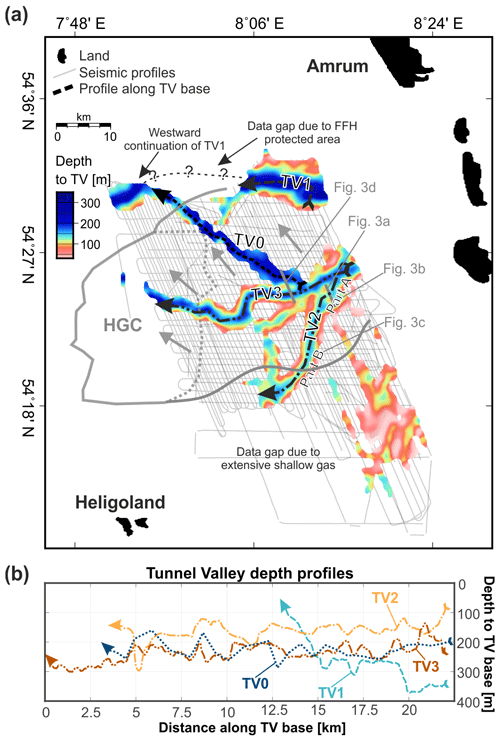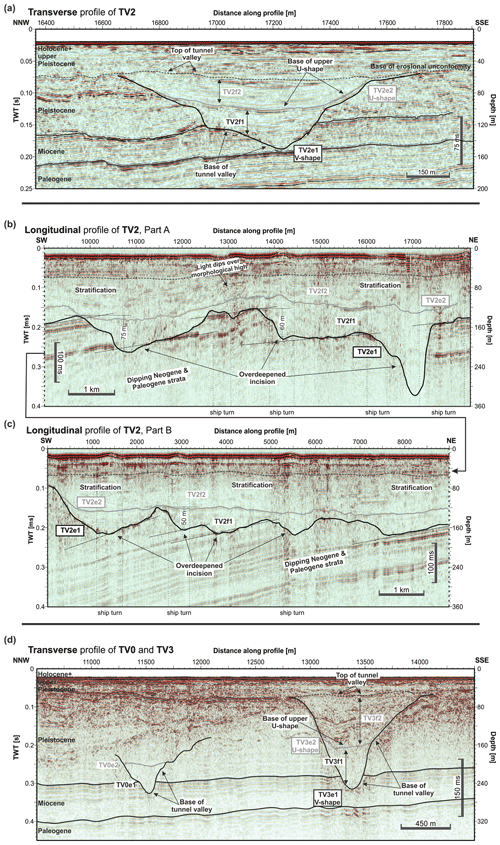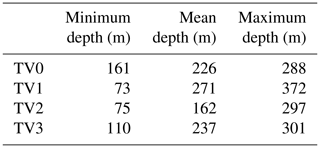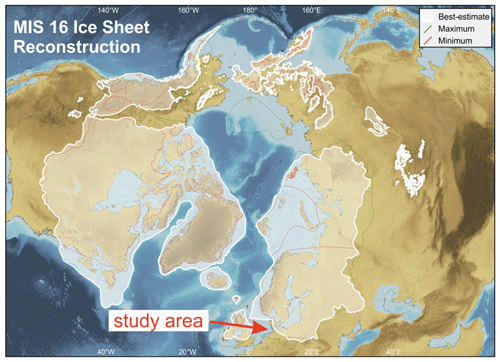Tunnel valleys in the southeastern North Sea: more data, more complexity
Large Pleistocene ice sheets have produced glacial structures both at and below the surface in northern Europe. Some of the largest and most erosive structures are so-called tunnel valleys (TVs): large and deep channels (typically up to 5 km wide and up to 400 m deep, with lengths up to 100 km), which formed below ice sheets. Although the subject of many studies, the details of their formation and fill are still not well understood. Here, we present an update on the distribution of TVs in the southeastern North Sea between Amrum and Heligoland based on a very dense grid of high-resolution 2D multi-channel reflection seismic data (400 m line spacing). The known tunnel valleys (TV1–TV3) in that area can now be traced in greater detail and further westwards, which results in an increased resolution and coverage of their distribution. Additionally, we were able to identify an even deeper and older tunnel valley, TV0, whose orientation parallels the thrust direction of the Heligoland Glacitectonic Complex (HGC). This observation implies a formation of TV0 before the HGC during an early-Elsterian or pre-Elsterian ice advance. For the first time, we acquired high-resolution longitudinal seismic profiles following the thalweg of known TVs. These longitudinal profiles offer clear indications of an incision during high-pressure bank-full conditions. The fill indicates sedimentation in an early high-energy environment for the lower part and a subsequent low-energy environment for the upper part. Our results demonstrate that a very dense profile spacing is required to decipher the complex incisions of TVs during multiple ice advances in a specific region. We also demonstrate that the time- and cost-effective acquisition of high-resolution 2D reflection seismic data holds the potential to further our understanding of the incision and filling mechanisms as well as of the distribution, complexity and incision depths of TVs in different geological settings.
Große pleistozäne Eisschilde haben in Nordeuropa glaziale Strukturen sowohl an der Oberfläche als auch unter der Oberfläche hinterlassen. Einige der größten und erosivsten Strukturen sind sogenannte Tunneltäler (TV); große und tiefe Rinnen (typischerweise bis zu 5 km breit, bis zu 400 m tief, mit einer Länge von bis zu 100 km), die sich unter Eisschilden gebildet haben. Die Bedingungen ihrer Entstehung und Verfüllung sind jedoch noch immer nicht genau verstanden. Hier zeigen wir eine Erweiterung der Verteilung von Tunneltälern in der südöstlichen Nordsee zwischen Amrum und Helgoland auf der Grundlage eines sehr dichten Netzes von hochauflösenden 2D-Mehrkanal-Reflexionsseismikdaten (400 m Profilabstand). Die bekannten Tunneltäler (TV1–TV3) in diesem Gebiet können nun detaillierter und weiter westlich verfolgt werden, was zu einer erhöhten Auflösung und Abdeckung ihrer Verteilung führt. Darüber hinaus konnten wir ein tieferes und älteres Tunneltal TV0 identifizieren, dessen Ausrichtung parallel zur Schubrichtung des Helgoland Glazialtektonischen Komplex (HGC) verläuft. Diese Beobachtung deutet auf eine Entstehung von TV0 vor dem HGC während eines früh- oder vor-elsterzeitlichen Eisvorstoßes hin. Zum ersten Mal haben wir hochauflösende seismische Profile genau entlang des Verlaufs der bekannten Tunneltäler aufgenommen. Diese Längsprofile liefern eindeutige Hinweise auf einen Einschnitt unter hohen Drücken. Die Füllung deutet auf eine Sedimentation während einer frühen hochenergetischen Phase für den unteren Teil und einer nachfolgenden niederenergetischen Phase für den oberen Teil hin. Unsere Ergebnisse zeigen, dass ein sehr dichter Profilabstand erforderlich ist, um die komplexen Einschnitte von Tunneltälern während mehrerer Eisvorstöße in einer ausgewählten Region zu entschlüsseln. Wir zeigen auch, dass die zeit- und kosteneffiziente Erfassung von hochauflösenden 2D-reflexionsseismischen Daten das Potenzial hat, unser Verständnis für die Erosions- und Füllmechanismen sowie für die Verteilung, Komplexität und Einschnitttiefen von Tunneltälern in verschiedenen geologischen Umgebungen zu verbessern.










